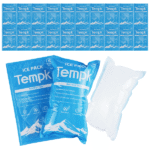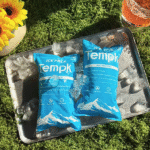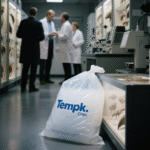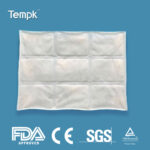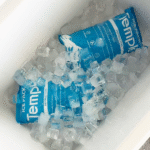Dry Ice or Ice Pack: Which Keeps Cargo Safer in 2025?
Need frozen steaks or chilled vaccines to arrive perfect? Choosing dry ice or ice pack correctly is the difference between a rock‑solid delivery and a soggy mess. Tests show dry ice stays at –78 °C but demands haz‑mat labels, while premium gel packs hover at 2 °C for up to 48 h. Below you’ll find clear rules, cost numbers, and a one‑click selector to nail your next shipment.
-
When does dry ice or ice pack fit your temperature window?
-
How do 2025 USPS and carrier rules differ for each option?
-
What do cost, weight, and sustainability look like side‑by‑side?
-
Which add‑ons (PCM, liners) boost performance most?
Dry Ice or Ice Pack—Which Fits Your Temperature Needs?
Dry ice wins below –18 °C; ice packs rule the 0–8 °C “cool‑chain.” Dry ice sublimates instead of melting, so it keeps ice cream or cell therapy products fully frozen for 24–72 h. Gel or PCM packs stabilize chilled produce, insulin, or biologics without freeze damage.
Outdoor trials confirm gel‑pack cores stay under 8 °C for 48 h inside a 2‑inch EPS shipper, while the same box with 5 lb of dry ice held –25 °C for 60 h. Pick based on the tightest temperature your product can tolerate.
Hold‑Time Cheat Sheet
| Payload Goal | Cooling Medium | Typical Hold‑Time (48 h ship) | Practical Benefit |
|---|---|---|---|
| –20 °C frozen | Dry ice (5 lb) | 48–60 h | No thaw risk for meat or ice cream |
| 0–8 °C chilled | Gel pack (4 lb) | 36–48 h | Prevents vaccine cold‑shock |
| 15–25 °C controlled | PCM pack (3 lb) | 24–36 h | Keeps test reagents room‑stable |
How Do Handling and Safety Compare?
Dry ice requires gloves, vented packaging, and “UN 1845” labels per USPS Instruction 9A. Packages must vent CO₂ gas and list net weight or they’ll be refused. In contrast, ice packs are non‑hazardous and can fly without special paperwork—but leak‑proof seams are vital for food contact.
-
Gloves & goggles: Dry ice frost‑bites at –78 °C; gel packs run –20 °C tops.
-
Regulatory cap: Air passengers may carry only 2.5 kg dry ice; no weight cap on gel packs.
-
CO₂ build‑up: A 10‑lb block in a van pushes CO₂ over 5 000 ppm in 30 min—crack the windows.
Leak and Spill Risks
A 2025 meat‑quality study showed that an ice‑pack placed directly on pork raised drip‑loss by 8 %, while proper separation cut the loss to 1 %. Always buffer gel packs with a liner to avoid wet spots.
What About Cost, Weight, and Sustainability?
| Factor | Dry Ice | Ice Pack / PCM | What It Means for You |
|---|---|---|---|
| Unit cost (avg.) | US $1.20 / lb | US $0.60 / lb (gel) — US $2.40 / lb (PCM) | Dry ice cheaper upfront; PCM pricey but reusable |
| Net weight impact | Sublimes to 0 | Adds return weight | Lower freight on dry ice, higher on gel packs |
| Carbon footprint | CO₂ release (often reclaimed) | Plastic film + gel landfill | Reclaimed pellets cut CO₂ by 15 % |
| Reusability | Single‑use | 30–100 cycles | Gel/PCM better for reverse logistics |
Bottom line: If freight cost dominates and you need freezer temps, go dry ice. For closed‑loop routes or chilled goods, reusable gel or PCM packs trim waste and paperwork.
Choosing Add‑On Insulation
-
Aerogel liners: Add 10–15 h hold‑time with no size penalty.
-
Reflective foil: Blocks 30 % radiant heat—cheap but crinkles.
-
Pre‑chill tactic: Cool the shipper overnight; saves 1–2 lb of dry ice or gel.
When Should You Choose Dry Ice or Ice Pack in 2025?
Use dry ice when the product must stay below –18 °C for over 24 h or carriers face delays. Examples include frozen meats, viral vectors, and ice cream subscriptions. Opt for ice pack or PCM when the target range is 0–8 °C or above and you can reclaim packaging.
| Scenario | Best Choice | Why |
|---|---|---|
| DTC frozen steak, 2‑day ground | Dry ice | Maintains deep‑freeze, lower box weight |
| Insulin overnight to clinic | Gel pack | Avoids accidental freezing |
| Temperature‑stable enzymes (20 °C) | PCM 22 °C | Precise room‑temp control |
2025 Trends Shaping the Dry Ice or Ice Pack Decision
Cloud‑based “cold‑route” engines now merge weather, lane data, and sublimation math to predict ice depletion within ±2 h. Pellet makers reclaim brewery CO₂, dropping dry‑ice prices 11 % in the past year. Meanwhile, gel‑pack films switched to bio‑PE, cutting plastic weight 18 %. Expect hybrid packs—tiny dry ice cores wrapped in PCM sleeves—for 72‑hour pharma lanes by 2027.
Snapshot of New Tech
-
Smart vent plugs: Alert if CO₂ builds above 3 000 ppm in transit.
-
Bio‑based gels: Compost‑tested under ASTM D6400.
-
AI pack selectors: Auto‑choose dry ice or ice pack per zip code weather.
Market insight: Hybrid coolants are forecast to grow at 14 % CAGR through 2028 as e‑commerce food boxes demand cheap yet label‑free cold.
FAQ
Will dry ice crack plastic food containers?
Only if pellets touch them directly; add cardboard to avoid thermal shock.
Can ice packs and dry ice ship together?
Yes—layer gel packs nearest the product and dry ice on top to vent outward.
How do I label ice packs for air transport?
No haz‑mat label needed; just meet the airline’s leak‑proof rule.
Key Takeaways
-
Choose dry ice or ice pack by temperature: below –18 °C versus 0–8 °C.
-
Dry ice is cheaper to ship but needs “UN 1845” labels and venting.
-
Reusable gel or PCM packs cut landfill waste and simplify paperwork.
-
Add smart liners and pre‑chill to shrink coolant mass by 15–20 %.
Next Steps
-
Try the selector tool above before booking your carrier.
-
Download our 2025 coolant cost sheet for side‑by‑side pricing.
-
Book a free packaging audit with Tempk’s cold‑chain engineers.
About Tempk
We engineer reclaimed‑CO₂ pellets, bio‑gel packs, and hybrid PCM sleeves validated in our ISTA 7E lab. Our route‑optimizer software selects dry ice or ice pack automatically—saving clients 12 % on freight last year.
Need the right coolant now? Chat with our specialists and ship cold with confidence.



















